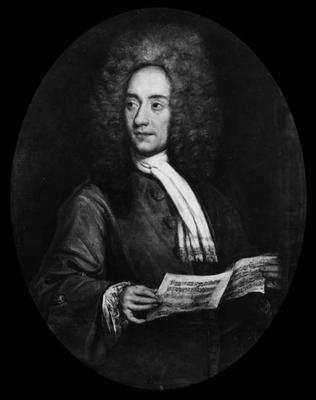<Back to Index>
- Mathematician Alicia Boole Stott, 1860
- Composer Tomaso Giovanni Albinoni, 1671
- King of England, Scotland and Ireland Charles II, 1630
PAGE SPONSOR

Tomaso Giovanni Albinoni (8 June 1671 – 17 January 1751) was a Venetian Baroque composer. While famous in his day as an opera composer, he is mainly remembered today for his instrumental music, such as the concertos, some of which are regularly recorded.
Born in Venice, Republic of Venice, to Antonio Albinoni, a wealthy paper merchant in Venice, he studied violin and singing. Relatively little is known about his life, especially considering his contemporary stature as a composer, and the comparatively well documented period in which he lived. In 1694 he dedicated his Opus 1 to the fellow Venetian, Cardinal Pietro Ottoboni (grand - nephew of Pope Alexander VIII); Ottoboni was an important patron in Rome of other composers, such as Arcangelo Corelli. Albinoni was possibly employed in 1700 as a violinist to Charles IV, Duke of Mantua, to whom he dedicated his Opus 2 collection of instrumental pieces. In 1701 he wrote his hugely popular suites Opus 3, and dedicated that collection to Cosimo III de' Medici, Grand Duke of Tuscany.
In 1705, he was married; Antonino Biffi, the maestro di cappella of San Marco was a witness, and evidently was a friend of Albinoni's. Albinoni seems to have no other connection with that primary musical establishment in Venice, however, and achieved his early fame as an opera composer at many cities in Italy, including Venice, Genoa, Bologna, Mantua, Udine, Piacenza, and Naples. During this time he was also composing instrumental music in abundance: prior to 1705, he mostly wrote trio sonatas and violin concertos, but between then and 1719 he wrote solo sonatas and concertos for oboe.
Unlike most composers of his time, he appears never to have sought a post at either a church or noble court, but then he was a man of independent means and had the option to compose music independently. In 1722, Maximilian II Emanuel, Elector of Bavaria, to whom Albinoni had dedicated a set of twelve concertos, invited him to direct two of his operas in Munich.
Around
1740, a collection of Albinoni's violin sonatas was published in France
as a posthumous work, and scholars long presumed that meant that
Albinoni had died by that time. However it appears he lived on in
Venice in obscurity; a record from the parish of San Barnaba indicates
Tomaso Albinoni died in Venice in 1751, of diabetes. He
wrote some fifty operas of which twenty - eight were produced in Venice
between 1723 and 1740, while there are modern sourcesattributing — possibly exaggeratedly and inaccurately — 81 operas to the composer. Today he is most noted for his instrumental music, especially his oboe concertos.
He is the first Italian known to employ the oboe as a solo instrument
in concerti (c. 1715, in his masterful 12 concerti a cinque, op. 7) and
publish such works, while it is likely that the first existing concerti featuring a solo oboe came from German composers such as Telemann or Händel, although probably unpublished. In Italy, Alessandro Marcello published
his well known oboe concerto in D minor a little later, in 1717.
Albinoni also employed the instrument often in his chamber works. His instrumental music greatly attracted the attention of Johann Sebastian Bach, who wrote at least two fugues on
Albinoni's themes (Fugue on a Theme by Albinoni in A, BWV 950, Fugue on
a Theme by Albinoni in B minor, BWV951) and constantly used his basses for harmony exercises for his pupils. Part of Albinoni's work was lost in World War II with the destruction of the Dresden State Library. As a result, little is known of his life and music after the mid 1720s. The Albinoni Adagio in G minor for violin, strings and organ, T. Mi 26, the subject of many modern recordings, was according to Remo Giazotto mainly written by himself. The 20th century musicologist Giazotto,
author of a biography of Albinoni, claimed to have discovered a tiny
manuscript fragment (consisting of a few measures of the melody line
and basso continuo portion) from a slow movement of an Albinoni trio sonata. According to Giazotto's account, the document had been sent to him by the Dresden State Library from among the relics of its collection, shortly after the end of World War II. Giazotto concluded it was a portion of a church sonata (sonata da chiesa) composed by Albinoni, possibly as part of the Op. 4 set, around 1708. According to Giazotto he
then constructed the balance of the complete single - movement work
around the fragmentary theme he ascribed to Albinoni, copyrighted it,
and published it in 1958. The Adagio is featured in the AFI award winning picture, Gallipoli, and was recorded by Jim Morrison and The Doors and used in their song "The Severed Garden".